The Rhode Island Music Hall of Fame
2014 Class of Inductees
All exhibits created by Jack
McKenna, official graphic designer for the RIMHOF
museum.
Click banners to enlarge.
Class of 2016 |
Class of 2015
|
Class of 2014
|
Class of 2013
|
Class of 2012
Class of 2012 - 2015
Slideshow
The Mark II
Winston Cogswell & Ray Peterson
|
Duke Robillard
|
Cheryl Wheeler
|
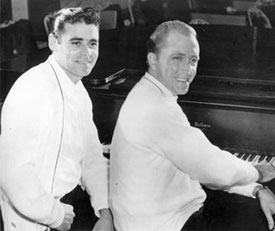 |
 |
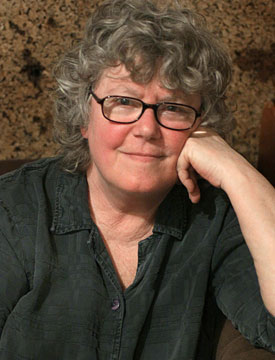 |
|
 Winston
Cogswell, of Warwick, was literally present at
the birth of Rock ’n’ Roll after moving to
Memphis, Tennessee in 1954. Working at Sam
Phillips’ Sun Records as a “jack of all trades”
– guitarist, pianist, songwriter, arranger,
producer and recording artist under the name
Wayne Powers – he collaborated with some of the
most important figures in music history
including Ray Harris, Johnny Cash, Jerry Lee
Lewis and Roy Orbison. He moved on to RCA Victor
in Nashville as a songwriter penning hits for
Chet Atkins and Skeeter Davis. Deciding he could
pursue his writing career without being on the
scene, he returned to Warwick in 1960 and began
collaborating with pianist/composer Ray
Peterson. The duo formed Wye Records with a
third partner, engineer Ken Dutton, and their
1960 debut release as The Mark II, “Night
Theme,” became a national hit. The song was
covered dozens of times around the world
including versions by Al Hirt, The Chantays, and
Lawrence Welk. Wye became the launching pad for
some of Rhode Island’s finest musicians and
remains the most successful label in state
history. More than 50 years later, Cogswell and
Peterson are still collaborating at the time of
their induction into the Rhode Island Music Hall
of Fame in 2014. Winston
Cogswell, of Warwick, was literally present at
the birth of Rock ’n’ Roll after moving to
Memphis, Tennessee in 1954. Working at Sam
Phillips’ Sun Records as a “jack of all trades”
– guitarist, pianist, songwriter, arranger,
producer and recording artist under the name
Wayne Powers – he collaborated with some of the
most important figures in music history
including Ray Harris, Johnny Cash, Jerry Lee
Lewis and Roy Orbison. He moved on to RCA Victor
in Nashville as a songwriter penning hits for
Chet Atkins and Skeeter Davis. Deciding he could
pursue his writing career without being on the
scene, he returned to Warwick in 1960 and began
collaborating with pianist/composer Ray
Peterson. The duo formed Wye Records with a
third partner, engineer Ken Dutton, and their
1960 debut release as The Mark II, “Night
Theme,” became a national hit. The song was
covered dozens of times around the world
including versions by Al Hirt, The Chantays, and
Lawrence Welk. Wye became the launching pad for
some of Rhode Island’s finest musicians and
remains the most successful label in state
history. More than 50 years later, Cogswell and
Peterson are still collaborating at the time of
their induction into the Rhode Island Music Hall
of Fame in 2014. |
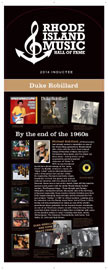 By the end of the 1960s, Michael Robillard, of
Woonsocket, had already earned a reputation as
one of the finest blues guitarists in Rhode
Island after stints with the short-lived
original lineup of Roomful of Blues, Ken Lyon’s
Tombstone Blues Band, and The Black Cat Blues
Band – during whose run he acquired his
world-renowned nickname of “Duke.” In 1970, he
was introduced to the horn-driven energy of the
“jump blues” via Buddy Johnson’s classic LP
“Rock ’n Roll” and he reformed Roomful with a
three-piece horn section. Under his leadership,
the band practically single-handedly revived the
genre and gained national attention with two
albums for Island Records. Never one to rest on
his laurels, Duke left the band to pursue a solo
career with his stellar Rhode Island rhythm
section, The Pleasure Kings – Thom Enright and
Tommy DeQuattro. During this period, the jazzier
side of his far-flung influences (especially the
Texas masters Charlie Christian and Herb Ellis)
began emerging more strongly and he released his
first jazz project, “Swing,” in 1987 to critical
acclaim. Leading up to his induction into the
Rhode Island Music Hall of Fame in 2014, he has
not only maintained his status as one of the
world’s finest blues guitarists, he has become
known worldwide as one of our greatest jazz
players as well. Along the way, he has recorded
and/or toured as a collaborator or sideman with
some of the greatest artists in music including
Herb Ellis, Jimmy Witherspoon, The Fabulous
Thunderbirds, Bob Dylan, Tom Waits, Dr. John and
Ruth Brown. By the end of the 1960s, Michael Robillard, of
Woonsocket, had already earned a reputation as
one of the finest blues guitarists in Rhode
Island after stints with the short-lived
original lineup of Roomful of Blues, Ken Lyon’s
Tombstone Blues Band, and The Black Cat Blues
Band – during whose run he acquired his
world-renowned nickname of “Duke.” In 1970, he
was introduced to the horn-driven energy of the
“jump blues” via Buddy Johnson’s classic LP
“Rock ’n Roll” and he reformed Roomful with a
three-piece horn section. Under his leadership,
the band practically single-handedly revived the
genre and gained national attention with two
albums for Island Records. Never one to rest on
his laurels, Duke left the band to pursue a solo
career with his stellar Rhode Island rhythm
section, The Pleasure Kings – Thom Enright and
Tommy DeQuattro. During this period, the jazzier
side of his far-flung influences (especially the
Texas masters Charlie Christian and Herb Ellis)
began emerging more strongly and he released his
first jazz project, “Swing,” in 1987 to critical
acclaim. Leading up to his induction into the
Rhode Island Music Hall of Fame in 2014, he has
not only maintained his status as one of the
world’s finest blues guitarists, he has become
known worldwide as one of our greatest jazz
players as well. Along the way, he has recorded
and/or toured as a collaborator or sideman with
some of the greatest artists in music including
Herb Ellis, Jimmy Witherspoon, The Fabulous
Thunderbirds, Bob Dylan, Tom Waits, Dr. John and
Ruth Brown. |
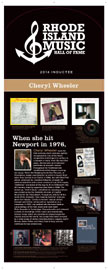 In 1976, Cheryl Wheeler moved to Rhode Island to
pursue a career in music on the Newport folk
scene. She took that scene by storm and was
quickly recognized as one of the finest
songwriters and singers to surface in a decade
or more. Over the next few years, she became an
in-demand performer at acoustic venues
throughout the Northeast and established artists
began covering her songs. When the fledgling
North Star Records, of Providence, began
searching for an artist to launch their label,
they zeroed in on Cheryl. In 1986, her
self-titled first album, produced by Jonathan
Edwards, brought her national attention and a
cover version of one of its tracks, “Addicted,”
was taken all the way to #1 on Billboard’s Top
40 Country chart by superstar Dan Seals in 1988.
The follow-up, “Half A Book,” solidified her
standing and she was picked up by the Nashville
division of Capitol Records for her third album.
Though she did not fit the mold of the Nashville
“star-making machine” and was given her release,
“Circles & Arrows” was an artistic triumph and
further enhanced her reputation as a composer.
In 1993, she settled into the more familiar
surroundings of the folk, blues and roots label
Philo/Rounder in Cambridge, Massachusetts and
released a series of recordings of her comic and
emotionally intense songs which are considered
singer/songwriter classics around the world. Her
songs have been covered by a wide range of
artists including Kenny Loggins, Garth Brooks,
Bette Midler and Peter, Paul & Mary and she
continues to tour extensively. In 1976, Cheryl Wheeler moved to Rhode Island to
pursue a career in music on the Newport folk
scene. She took that scene by storm and was
quickly recognized as one of the finest
songwriters and singers to surface in a decade
or more. Over the next few years, she became an
in-demand performer at acoustic venues
throughout the Northeast and established artists
began covering her songs. When the fledgling
North Star Records, of Providence, began
searching for an artist to launch their label,
they zeroed in on Cheryl. In 1986, her
self-titled first album, produced by Jonathan
Edwards, brought her national attention and a
cover version of one of its tracks, “Addicted,”
was taken all the way to #1 on Billboard’s Top
40 Country chart by superstar Dan Seals in 1988.
The follow-up, “Half A Book,” solidified her
standing and she was picked up by the Nashville
division of Capitol Records for her third album.
Though she did not fit the mold of the Nashville
“star-making machine” and was given her release,
“Circles & Arrows” was an artistic triumph and
further enhanced her reputation as a composer.
In 1993, she settled into the more familiar
surroundings of the folk, blues and roots label
Philo/Rounder in Cambridge, Massachusetts and
released a series of recordings of her comic and
emotionally intense songs which are considered
singer/songwriter classics around the world. Her
songs have been covered by a wide range of
artists including Kenny Loggins, Garth Brooks,
Bette Midler and Peter, Paul & Mary and she
continues to tour extensively. |
Freddie Scott
(1933-2007)
|
Randy Hien
(1949 - 2006)
|
Francis
Madeira
|
|
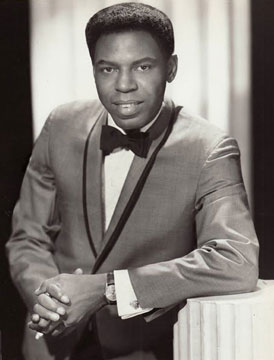 |
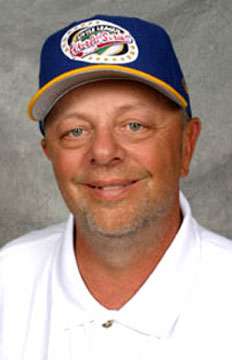 |
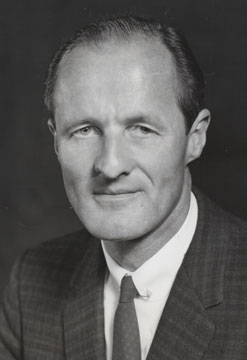 |
|
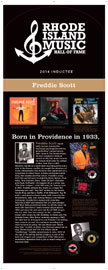 Freddie was
born in Providence in 1933. He found
early success touring the Northeast
and England with his grandmother’s
gospel group, Sally Jones & The
Gospel Keyes. He next enrolled in
medical school at URI, but music
became his chosen field when he
settled in New York City in 1956.
Between rounds as a small label
recording artist and songwriter and
a stint in the Korean conflict, he
caught the attention of music
entrepreneur Don Kirshner who signed
him as a songwriter with Aldon
Music, then home to Carole King,
Barry Mann, Neil Sedaka and Paul
Simon. Freddie’s songs from this
period were recorded by Ricky
Nelson, Paul Anka, Tony Orlando,
Gene “Duke Of Earl” Chandler and
Clyde McPhatter. His biggest hit as
a writer was “The Door Is Open,” a
Hot 100 entry for Tommy Hunt in
1962. Freddie entered the charts as
a singer himself the following year
with “Hey Girl” written by his
friends Carole King and Gerry Goffin.
It hit Billboard’s Top 10 and is
considered a classic today with
covers by the Temptations, Bobby Vee,
Donny Osmond, Billy Joel, George
Benson and Michael McDonald. Freddie
then signed with Columbia Records in
1964 and released two LPs and four
singles, but major labels did not
know how to nurture R&B talent in
the early ‘60s, so, as did Aretha
Franklin, Freddie left the label.
Bert Berns, on the other hand, was a
solid R&B producer and approached
Freddie to sign with his
newly-formed Shout label in 1966.
Early the next year, Freddie had the
#1 R&B song in the US with “Are You
Lonely For Me” – another classic
with covers by Otis Redding, Chuck
Jackson, Al Green and the Grateful
Dead. Freddie did well at Shout, but
with Berns’ untimely passing in
1967, the label lost its driving
force. And so, Freddie’s hit making
days came to an end, but he
continued recording occasional
singles, albums and jingles and even
tried his hand at acting. His last
album was “Brand New Man” in 2001
and in 2003 he recorded “Brown-Eyed
Girl” for the Van Morrison tribute
album, “Vanthology.” Freddie passed
away in June, 2007, at the age of 74
leaving behind a legacy as one of
the best soul singers and
songwriters of the ‘60s and a
worldwide reputation that is just as
intact today as it was back then.
His success remains a great source
of pride for the Rhode Island music
community. Freddie was
born in Providence in 1933. He found
early success touring the Northeast
and England with his grandmother’s
gospel group, Sally Jones & The
Gospel Keyes. He next enrolled in
medical school at URI, but music
became his chosen field when he
settled in New York City in 1956.
Between rounds as a small label
recording artist and songwriter and
a stint in the Korean conflict, he
caught the attention of music
entrepreneur Don Kirshner who signed
him as a songwriter with Aldon
Music, then home to Carole King,
Barry Mann, Neil Sedaka and Paul
Simon. Freddie’s songs from this
period were recorded by Ricky
Nelson, Paul Anka, Tony Orlando,
Gene “Duke Of Earl” Chandler and
Clyde McPhatter. His biggest hit as
a writer was “The Door Is Open,” a
Hot 100 entry for Tommy Hunt in
1962. Freddie entered the charts as
a singer himself the following year
with “Hey Girl” written by his
friends Carole King and Gerry Goffin.
It hit Billboard’s Top 10 and is
considered a classic today with
covers by the Temptations, Bobby Vee,
Donny Osmond, Billy Joel, George
Benson and Michael McDonald. Freddie
then signed with Columbia Records in
1964 and released two LPs and four
singles, but major labels did not
know how to nurture R&B talent in
the early ‘60s, so, as did Aretha
Franklin, Freddie left the label.
Bert Berns, on the other hand, was a
solid R&B producer and approached
Freddie to sign with his
newly-formed Shout label in 1966.
Early the next year, Freddie had the
#1 R&B song in the US with “Are You
Lonely For Me” – another classic
with covers by Otis Redding, Chuck
Jackson, Al Green and the Grateful
Dead. Freddie did well at Shout, but
with Berns’ untimely passing in
1967, the label lost its driving
force. And so, Freddie’s hit making
days came to an end, but he
continued recording occasional
singles, albums and jingles and even
tried his hand at acting. His last
album was “Brand New Man” in 2001
and in 2003 he recorded “Brown-Eyed
Girl” for the Van Morrison tribute
album, “Vanthology.” Freddie passed
away in June, 2007, at the age of 74
leaving behind a legacy as one of
the best soul singers and
songwriters of the ‘60s and a
worldwide reputation that is just as
intact today as it was back then.
His success remains a great source
of pride for the Rhode Island music
community.
|
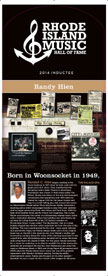 Randall C. Hien
was born in Woonsocket in 1949. He
was the great-nephew of entrepreneur
B.A. Dario who built and owned
Lincoln Downs Race Track and owned
major venues such as the RKO Albee
Theatre and the Loew's State Theatre
which is now the Providence
Performing Arts Center. Randy began
working in the music business in
1971 when he took a job with his
great-uncle who had recently
purchased the decaying Loew’s. They
changed the name to the Palace
Theatre as a venue for Rock ’n’ Roll
concerts. Randy was liaison to the
acts and managed concessions and
venue operations until 1975 when
Dario decided it was not financially
feasible to keep the doors open any
longer. By this point Randy was
certain he wanted to continue
promoting music but needed a venue
to do it in. He approached Arnold
Hahn who had a small, failing jazz
club at the corner of Westminster
and Empire Streets called The Living
Room, just blocks from the Palace.
Randy had no real money, but offered
Hahn his Jaguar XKE for the keys to
the club and the liquor license.
Hahn gladly took the offer to rid
himself of what he considered a
major headache. The early days for
Randy were very difficult, but with
the help of his friend Carl Sugarman
and a booking policy which
encouraged bands to play their own
material, by 1980 the club had
become the center of a blossoming
original music scene with a
dedicated clientele. The future
looked promising until his
great-uncle, who also happened to
own that building, decided to sell
the property which was torn down to
make way for a new Federal office
building. Randy set up shop for
Living Room #2 in a warehouse on
Promenade St. It was called “the
bubble complex” due to a large
bubble-shaped bay window which
extended out from the side of the
building. This was a great period
for Randy and the club scene with
many great local and national acts
on the bill. Even Randy’s mother got
involved by cooking dinner for many
of the starving musicians. It was a
great time until the building owner
decided not to renew Randy’s lease
and the Living Room #2 came to a
close in 1990. For five years, Randy
searched for a venue he could buy so
he that he wouldn’t be at the mercy
of a landlord. Living Room #3 was
purchased in 1995 and prospered
until 2006 when the Rhode Island
music scene lost one of its greatest
supporters with Randy’s untimely
passing. During his entire
entertainment career, Randy also
focused on his other passion –
baseball. He was a coach for the
Lincoln Little League for 28 years. Randall C. Hien
was born in Woonsocket in 1949. He
was the great-nephew of entrepreneur
B.A. Dario who built and owned
Lincoln Downs Race Track and owned
major venues such as the RKO Albee
Theatre and the Loew's State Theatre
which is now the Providence
Performing Arts Center. Randy began
working in the music business in
1971 when he took a job with his
great-uncle who had recently
purchased the decaying Loew’s. They
changed the name to the Palace
Theatre as a venue for Rock ’n’ Roll
concerts. Randy was liaison to the
acts and managed concessions and
venue operations until 1975 when
Dario decided it was not financially
feasible to keep the doors open any
longer. By this point Randy was
certain he wanted to continue
promoting music but needed a venue
to do it in. He approached Arnold
Hahn who had a small, failing jazz
club at the corner of Westminster
and Empire Streets called The Living
Room, just blocks from the Palace.
Randy had no real money, but offered
Hahn his Jaguar XKE for the keys to
the club and the liquor license.
Hahn gladly took the offer to rid
himself of what he considered a
major headache. The early days for
Randy were very difficult, but with
the help of his friend Carl Sugarman
and a booking policy which
encouraged bands to play their own
material, by 1980 the club had
become the center of a blossoming
original music scene with a
dedicated clientele. The future
looked promising until his
great-uncle, who also happened to
own that building, decided to sell
the property which was torn down to
make way for a new Federal office
building. Randy set up shop for
Living Room #2 in a warehouse on
Promenade St. It was called “the
bubble complex” due to a large
bubble-shaped bay window which
extended out from the side of the
building. This was a great period
for Randy and the club scene with
many great local and national acts
on the bill. Even Randy’s mother got
involved by cooking dinner for many
of the starving musicians. It was a
great time until the building owner
decided not to renew Randy’s lease
and the Living Room #2 came to a
close in 1990. For five years, Randy
searched for a venue he could buy so
he that he wouldn’t be at the mercy
of a landlord. Living Room #3 was
purchased in 1995 and prospered
until 2006 when the Rhode Island
music scene lost one of its greatest
supporters with Randy’s untimely
passing. During his entire
entertainment career, Randy also
focused on his other passion –
baseball. He was a coach for the
Lincoln Little League for 28 years. |
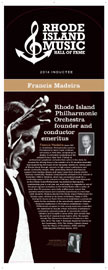 Rhode Island
Philharmonic Orchestra founder and
conductor emeritus Francis Madeira
(born 1917 in Jenkintown, PA) came
to Providence to teach music at
Brown University in 1943 after
completing his studies in orchestral
conducting at the Juilliard School,
New York. Finding no professional
symphonic orchestra then active in
the state he became the driving
force in the creation of a 30-member
ensemble that would bring the music
of the European masters to various
parts of Rhode Island through
concerts in high school auditoriums
and similar community venues. After
generating interest and financial
support from leading citizens and
music lovers from Rhode Island's
business community, Madeira
conducted the orchestra's first
concert in November, 1944 in
Westerly, which was successful
enough for a continuing season of
six concerts in February, 1945. From
that point on the Rhode Island
Philharmonic has delivered
high-quality musicianship year in
and year out, and today it is
regarded as one of the great
regional orchestras in the United
States with a roster of more than 70
musicians and a fully staffed music
school that provides weekly lessons
and ensemble experiences to more
than 1,500 students. Madeira
directed the Rhode Island
Philharmonic for 30-plus years,
retiring to his home in Portland,
Maine in 1978. During his tenure as
Music Director he established a
permanent home for the orchestra at
the acoustically superior Veterans
Memorial Auditorium in Providence;
established a Youth Philharmonic
program to train young musicians;
expanded the repertoire to include a
Pops Orchestra; maintained a
community outreach program of
concerts for school children; and
brought in some of the best soloists
that the world of classical music
had to offer. His awards include The
Governor's Award for Excellence in
the Arts, 1972; The John F. Kennedy
Award for Service to the Community,
1978; The Citizen Citation Award
from the Mayor of Providence, 2003;
and the Distinguished Alumnus Award,
2010. Rhode Island
Philharmonic Orchestra founder and
conductor emeritus Francis Madeira
(born 1917 in Jenkintown, PA) came
to Providence to teach music at
Brown University in 1943 after
completing his studies in orchestral
conducting at the Juilliard School,
New York. Finding no professional
symphonic orchestra then active in
the state he became the driving
force in the creation of a 30-member
ensemble that would bring the music
of the European masters to various
parts of Rhode Island through
concerts in high school auditoriums
and similar community venues. After
generating interest and financial
support from leading citizens and
music lovers from Rhode Island's
business community, Madeira
conducted the orchestra's first
concert in November, 1944 in
Westerly, which was successful
enough for a continuing season of
six concerts in February, 1945. From
that point on the Rhode Island
Philharmonic has delivered
high-quality musicianship year in
and year out, and today it is
regarded as one of the great
regional orchestras in the United
States with a roster of more than 70
musicians and a fully staffed music
school that provides weekly lessons
and ensemble experiences to more
than 1,500 students. Madeira
directed the Rhode Island
Philharmonic for 30-plus years,
retiring to his home in Portland,
Maine in 1978. During his tenure as
Music Director he established a
permanent home for the orchestra at
the acoustically superior Veterans
Memorial Auditorium in Providence;
established a Youth Philharmonic
program to train young musicians;
expanded the repertoire to include a
Pops Orchestra; maintained a
community outreach program of
concerts for school children; and
brought in some of the best soloists
that the world of classical music
had to offer. His awards include The
Governor's Award for Excellence in
the Arts, 1972; The John F. Kennedy
Award for Service to the Community,
1978; The Citizen Citation Award
from the Mayor of Providence, 2003;
and the Distinguished Alumnus Award,
2010. |
Tavares
|
Paul Gonsalves
(1920 - 1974)
|
Castaleers
|
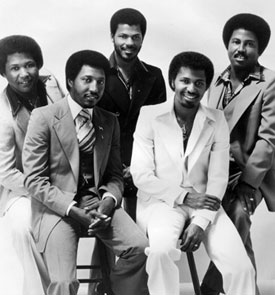 |
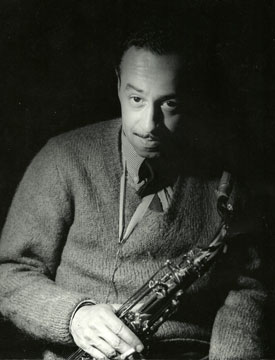 |
 |
|
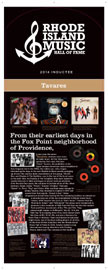 From their earliest
days in the Fox Point neighborhood of
Providence, it was clear the seven
Tavares brothers were born to make
music. At first, they were guided by
their dad, Feliciano “Flash” Tavares,
the godfather of the Cape
Verdean-American musical tradition in
New England, but in the 1950s, the
oldest son, John, began introducing the
boys to the new Rhythm & Blues sounds
springing up all over the country. Early
incarnations of the group, The Del Rios
and Chubby & The Realities, rose to the
top of the local scene in the early
’60s. As Chubby & The Turnpikes, they
were signed to Capitol Records in 1968
and began to attract national attention.
Over the next four years, the act grew
to include all six of the other
brothers: Ralph, Arthur “Pooch,” Antone
“Chubby,” Feliciano “Butch” Jr., Perry
“Tiny” and Victor. After one final name
change to simply Tavares, they returned
to Capitol in 1973 and scored their
first big hit, “Check It Out.” Victor
dropped out at that time leaving the
five remaining brothers to embark on a
decade-long run at the top unparalleled
in Rhode Island music history. With
massive hits such as “She’s Gone,”
“Heaven Must Be Missing An Angel,” and
“Whodunit,” the group were recognized as
pioneers in the evolution of R&B from
the Soul era into the modern Funk and
Disco movements of the ’70s and ’80s.
They placed eight singles on Billboard’s
Top 40, 12 in the R&B Top 10 (including
three #1 hits), three Dance Chart hits
(two at #1), 10 hit LPs, and won a
Grammy for “More Than A Woman,” their
contribution to "Saturday Night Fever,"
one of the best-selling albums of all
time. At the time of their induction
into the Rhode Island Music Hall of Fame
in 2014, Tavares remains a top
international touring attraction with
Chubby, Pooch, Butch and Tiny carrying
on the tradition. From their earliest
days in the Fox Point neighborhood of
Providence, it was clear the seven
Tavares brothers were born to make
music. At first, they were guided by
their dad, Feliciano “Flash” Tavares,
the godfather of the Cape
Verdean-American musical tradition in
New England, but in the 1950s, the
oldest son, John, began introducing the
boys to the new Rhythm & Blues sounds
springing up all over the country. Early
incarnations of the group, The Del Rios
and Chubby & The Realities, rose to the
top of the local scene in the early
’60s. As Chubby & The Turnpikes, they
were signed to Capitol Records in 1968
and began to attract national attention.
Over the next four years, the act grew
to include all six of the other
brothers: Ralph, Arthur “Pooch,” Antone
“Chubby,” Feliciano “Butch” Jr., Perry
“Tiny” and Victor. After one final name
change to simply Tavares, they returned
to Capitol in 1973 and scored their
first big hit, “Check It Out.” Victor
dropped out at that time leaving the
five remaining brothers to embark on a
decade-long run at the top unparalleled
in Rhode Island music history. With
massive hits such as “She’s Gone,”
“Heaven Must Be Missing An Angel,” and
“Whodunit,” the group were recognized as
pioneers in the evolution of R&B from
the Soul era into the modern Funk and
Disco movements of the ’70s and ’80s.
They placed eight singles on Billboard’s
Top 40, 12 in the R&B Top 10 (including
three #1 hits), three Dance Chart hits
(two at #1), 10 hit LPs, and won a
Grammy for “More Than A Woman,” their
contribution to "Saturday Night Fever,"
one of the best-selling albums of all
time. At the time of their induction
into the Rhode Island Music Hall of Fame
in 2014, Tavares remains a top
international touring attraction with
Chubby, Pooch, Butch and Tiny carrying
on the tradition. |
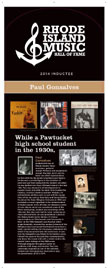 While a Pawtucket
high school student in the 1930s, Paul
Gonsalves studied with two of Rhode
Island’s finest musicians, guitarist
Joseph Petteruti and saxophonist Joseph
Piacitelli, but it was his tenor sax
which opened doors for him with the big
bands including Count Basie’s. He became
a pivotal figure in the evolution of
post-war jazz from swing into the modern
era when he was drafted into Dizzy
Gillespie’s band in the late ’40s. Paul
was attuned to all developments in
popular music and while his warm tone
invoked the masters, Coleman Hawkins and
Ben Webster, his extraordinary abilities
were on par with the young lions of the
era such as Stan Getz and Sonny Rollins.
He joined the Duke Ellington Orchestra
in 1950 and provided a crucial
ingredient in the modernization of
Duke’s sound. In his off time, he
released a series of solo albums which
are considered some of the finest
small-group, modern jazz recordings of
the ‘50s and ’60s. But even had he never
racked up so many achievements, he was
guaranteed a place in the history books
by his famous 27 chorus improvisation on
“Diminuendo and Crescendo In Blue” at
the 1956 Newport Jazz Festival which
single-handedly reversed the waning
fortunes of the Ellington band and
turned the festival’s tone from a staid,
concert setting into the joyous
celebration for which it has become
known the world over. In one solo, he
managed to pay tribute to his mentors,
prove himself the equal of his post-Bop
contemporaries, and drive the crowd wild
with a rockin’ nod to the honkin’ tenor
stylings of the R&B scene. Although
plagued throughout career by problems
with drugs and alcohol, Paul was
universally regarded as one of the
warmest, kindest and generous musicians
in jazz. He passed away at 53 in 1974. While a Pawtucket
high school student in the 1930s, Paul
Gonsalves studied with two of Rhode
Island’s finest musicians, guitarist
Joseph Petteruti and saxophonist Joseph
Piacitelli, but it was his tenor sax
which opened doors for him with the big
bands including Count Basie’s. He became
a pivotal figure in the evolution of
post-war jazz from swing into the modern
era when he was drafted into Dizzy
Gillespie’s band in the late ’40s. Paul
was attuned to all developments in
popular music and while his warm tone
invoked the masters, Coleman Hawkins and
Ben Webster, his extraordinary abilities
were on par with the young lions of the
era such as Stan Getz and Sonny Rollins.
He joined the Duke Ellington Orchestra
in 1950 and provided a crucial
ingredient in the modernization of
Duke’s sound. In his off time, he
released a series of solo albums which
are considered some of the finest
small-group, modern jazz recordings of
the ‘50s and ’60s. But even had he never
racked up so many achievements, he was
guaranteed a place in the history books
by his famous 27 chorus improvisation on
“Diminuendo and Crescendo In Blue” at
the 1956 Newport Jazz Festival which
single-handedly reversed the waning
fortunes of the Ellington band and
turned the festival’s tone from a staid,
concert setting into the joyous
celebration for which it has become
known the world over. In one solo, he
managed to pay tribute to his mentors,
prove himself the equal of his post-Bop
contemporaries, and drive the crowd wild
with a rockin’ nod to the honkin’ tenor
stylings of the R&B scene. Although
plagued throughout career by problems
with drugs and alcohol, Paul was
universally regarded as one of the
warmest, kindest and generous musicians
in jazz. He passed away at 53 in 1974. |
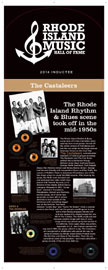 The Rhode Island
Rhythm & Blues scene began in the
mid-1950s when aspiring teen vocal
groups moved off the street corners of
Providence and into the rec center at
the Doyle Avenue Grammar School on the
East Side. The Castaleers evolved when
members of various groups including The
Parakeets and The Five Tones settled
into a permanent lineup: Richard Jones
(lead, baritone/tenor), George Smith
(baritone), Dell Padgett (bass), Ron
Henries (tenor) and Benny Barros
(tenor). George had become friendly with
songwriters Myron and Ray Muffs, the
owners of Muffet’s Music Store in
downtown Providence, one of the few
shops in town where he could find R&B
records. After hearing the group, the
Muffs were knocked out and produced four
sides which they placed with Felsted
Records, a U.S. division of the mighty
British Decca company. Released in 1957,
“Come Back” charted in Providence,
Philadelphia, Detroit and Montreal, but
the group, all of whom had good jobs or
were still in school, declined to tour
outside of the Northeast until something
bigger was on the horizon. Two more
releases also fared well, but the
group’s unwillingness to tour nationally
led to them being dropped. Henries left
and was replaced by singer/songwriter
Joe Hill of The 5 Dukes and The Dials.
The Muffs produced another session on
two of Joe’s songs and placed the master
with L.A. label Donna/Del-Fi, home to
Ron Holden and Ritchie Valens. Once
again, there was action, especially in
Los Angeles, but it never reached the
top and in 1961, the group called it a
day. Still, the Castaleers are
recognized as trailblazers for Rhode
Island artists who paved the way for
national releases by Freddie Scott, The
Del Rios (Tavares) and Dipsy & The
Doodles. Their 45s are considered some
of the greatest – and most collectible –
group records of the pre-Soul R&B era. The Rhode Island
Rhythm & Blues scene began in the
mid-1950s when aspiring teen vocal
groups moved off the street corners of
Providence and into the rec center at
the Doyle Avenue Grammar School on the
East Side. The Castaleers evolved when
members of various groups including The
Parakeets and The Five Tones settled
into a permanent lineup: Richard Jones
(lead, baritone/tenor), George Smith
(baritone), Dell Padgett (bass), Ron
Henries (tenor) and Benny Barros
(tenor). George had become friendly with
songwriters Myron and Ray Muffs, the
owners of Muffet’s Music Store in
downtown Providence, one of the few
shops in town where he could find R&B
records. After hearing the group, the
Muffs were knocked out and produced four
sides which they placed with Felsted
Records, a U.S. division of the mighty
British Decca company. Released in 1957,
“Come Back” charted in Providence,
Philadelphia, Detroit and Montreal, but
the group, all of whom had good jobs or
were still in school, declined to tour
outside of the Northeast until something
bigger was on the horizon. Two more
releases also fared well, but the
group’s unwillingness to tour nationally
led to them being dropped. Henries left
and was replaced by singer/songwriter
Joe Hill of The 5 Dukes and The Dials.
The Muffs produced another session on
two of Joe’s songs and placed the master
with L.A. label Donna/Del-Fi, home to
Ron Holden and Ritchie Valens. Once
again, there was action, especially in
Los Angeles, but it never reached the
top and in 1961, the group called it a
day. Still, the Castaleers are
recognized as trailblazers for Rhode
Island artists who paved the way for
national releases by Freddie Scott, The
Del Rios (Tavares) and Dipsy & The
Doodles. Their 45s are considered some
of the greatest – and most collectible –
group records of the pre-Soul R&B era. |
Class of 2016 |
Class of 2015
|
Class of 2014
|
Class of 2013
|
Class of 2012
Class of 2012 - 2015
Slideshow
|
|